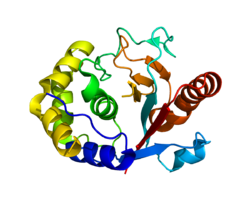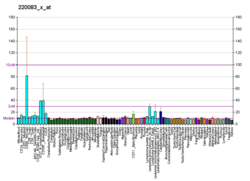| UCHL5 |
|---|
 |
| Available structures |
|---|
| PDB | Ortholog search: PDBe RCSB |
|---|
| List of PDB id codes |
|---|
3A7S, 3IHR, 3RII, 3RIS, 3TB3, 4UEL, 4UEM, 4UF5, 4UF6, 4WLP |
|
|
| Identifiers |
|---|
| Aliases | UCHL5, CGI-70, INO80R, UCH-L5, UCH37, Ubiquitin carboxyl-terminal hydrolase L5, ubiquitin C-terminal hydrolase L5 |
|---|
| External IDs | OMIM: 610667; MGI: 1914848; HomoloGene: 9326; GeneCards: UCHL5; OMA:UCHL5 - orthologs |
|---|
| Gene location (Human) |
|---|
 | | Chr. | Chromosome 1 (human)[1] |
|---|
| | Band | 1q31.2 | Start | 193,012,250 bp[1] |
|---|
| End | 193,060,080 bp[1] |
|---|
|
| Gene location (Mouse) |
|---|
 | | Chr. | Chromosome 1 (mouse)[2] |
|---|
| | Band | 1 F|1 62.54 cM | Start | 143,653,010 bp[2] |
|---|
| End | 143,683,204 bp[2] |
|---|
|
| RNA expression pattern |
|---|
| Bgee | | Human | Mouse (ortholog) |
|---|
| Top expressed in | - Achilles tendon
- islet of Langerhans
- body of pancreas
- prefrontal cortex
- muscle of thigh
- rectum
- monocyte
- gonad
- gastrocnemius muscle
- epithelium of colon
|
| | Top expressed in | - morula
- embryo
- blastocyst
- yolk sac
- parotid gland
- otic placode
- tail of embryo
- medial vestibular nucleus
- deep cerebellar nuclei
- epiblast
|
| | More reference expression data |
|
|---|
| BioGPS | 
 | | More reference expression data |
|
|---|
|
| Gene ontology |
|---|
| Molecular function | - cysteine-type peptidase activity
- thiol-dependent deubiquitinase
- peptidase activity
- protein binding
- endopeptidase inhibitor activity
- hydrolase activity
- RNA binding
- proteasome binding
| | Cellular component | - cytoplasm
- intracellular anatomical structure
- proteasome complex
- nucleus
- cytosolic proteasome complex
- nucleoplasm
- mitochondrion
- cytosol
- Ino80 complex
| | Biological process | - regulation of proteasomal protein catabolic process
- DNA recombination
- regulation of transcription, DNA-templated
- lateral ventricle development
- ubiquitin-dependent protein catabolic process
- transcription, DNA-templated
- proteolysis
- cellular response to DNA damage stimulus
- forebrain morphogenesis
- DNA repair
- midbrain development
- negative regulation of endopeptidase activity
- protein deubiquitination
- negative regulation of proteasomal ubiquitin-dependent protein catabolic process
| | Sources:Amigo / QuickGO |
|
| Orthologs |
|---|
| Species | Human | Mouse |
|---|
| Entrez | | |
|---|
| Ensembl | | |
|---|
| UniProt | | |
|---|
| RefSeq (mRNA) | NM_001199261
NM_001199262
NM_001199263
NM_015984
NM_001350840
|
|---|
NM_001350841
NM_001350842
NM_001350843
NM_001350844
NM_001350845
NM_001350846
NM_001350847
NM_001350848
NM_001350849
NM_001350850
NM_001350851
NM_001350852 |
| |
|---|
| RefSeq (protein) | NP_001186190
NP_001186191
NP_001186192
NP_057068
NP_001337769
|
|---|
NP_001337770
NP_001337771
NP_001337772
NP_001337773
NP_001337774
NP_001337775
NP_001337776
NP_001337777
NP_001337778
NP_001337779
NP_001337780
NP_001337781 |
| |
|---|
| Location (UCSC) | Chr 1: 193.01 – 193.06 Mb | Chr 1: 143.65 – 143.68 Mb |
|---|
| PubMed search | [3] | [4] |
|---|
|
| Wikidata |
| View/Edit Human | View/Edit Mouse |
|




















